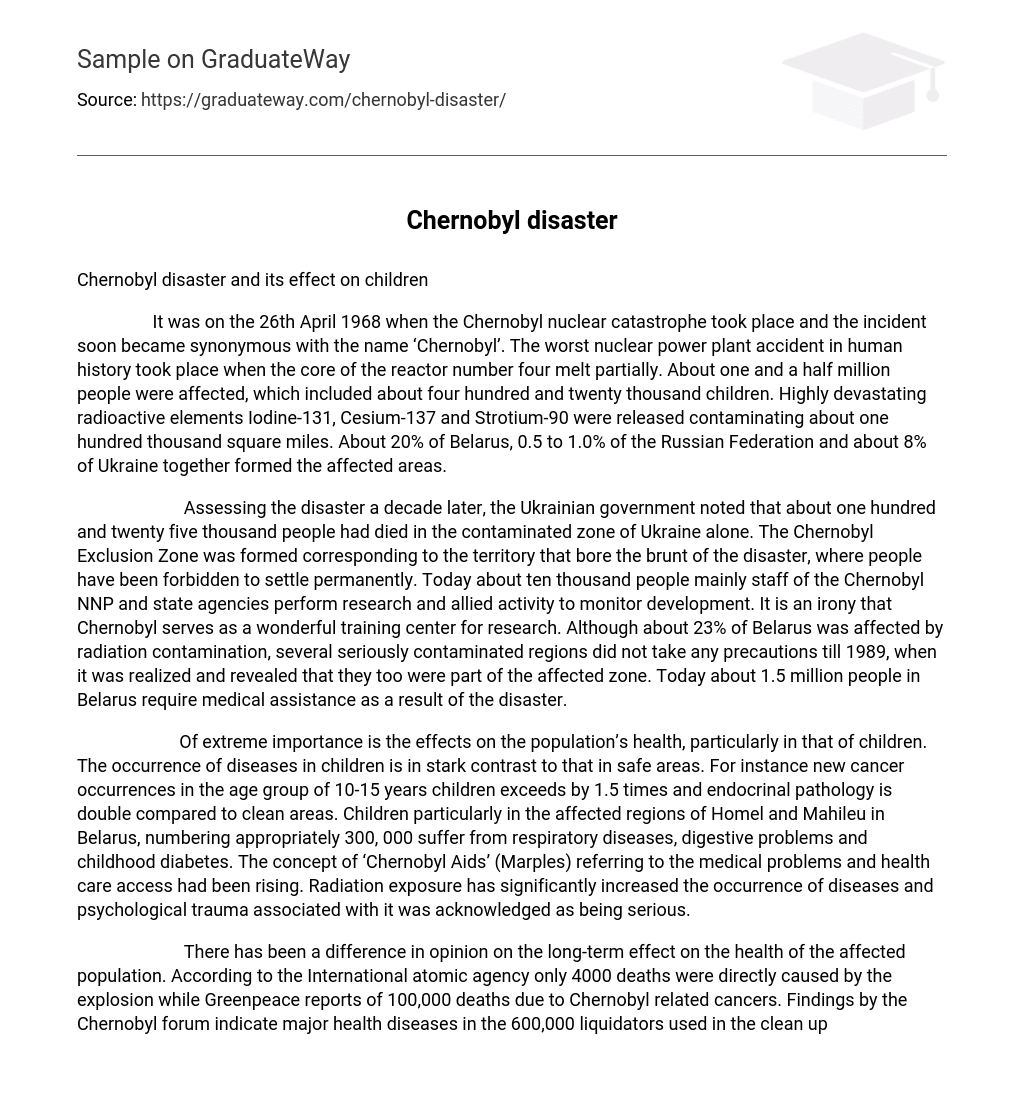It was on the 26th April 1968 when the Chernobyl nuclear catastrophe took place and the incident soon became synonymous with the name ‘Chernobyl’. The worst nuclear power plant accident in human history took place when the core of the reactor number four melt partially. About one and a half million people were affected, which included about four hundred and twenty thousand children. Highly devastating radioactive elements Iodine-131, Cesium-137 and Strotium-90 were released contaminating about one hundred thousand square miles. About 20% of Belarus, 0.5 to 1.0% of the Russian Federation and about 8% of Ukraine together formed the affected areas.
Assessing the disaster a decade later, the Ukrainian government noted that about one hundred and twenty five thousand people had died in the contaminated zone of Ukraine alone. The Chernobyl Exclusion Zone was formed corresponding to the territory that bore the brunt of the disaster, where people have been forbidden to settle permanently. Today about ten thousand people mainly staff of the Chernobyl NNP and state agencies perform research and allied activity to monitor development. It is an irony that Chernobyl serves as a wonderful training center for research. Although about 23% of Belarus was affected by radiation contamination, several seriously contaminated regions did not take any precautions till 1989, when it was realized and revealed that they too were part of the affected zone. Today about 1.5 million people in Belarus require medical assistance as a result of the disaster.
Of extreme importance is the effects on the population’s health, particularly in that of children. The occurrence of diseases in children is in stark contrast to that in safe areas. For instance new cancer occurrences in the age group of 10-15 years children exceeds by 1.5 times and endocrinal pathology is double compared to clean areas. Children particularly in the affected regions of Homel and Mahileu in Belarus, numbering appropriately 300, 000 suffer from respiratory diseases, digestive problems and childhood diabetes. The concept of ‘Chernobyl Aids’ (Marples) referring to the medical problems and health care access had been rising. Radiation exposure has significantly increased the occurrence of diseases and psychological trauma associated with it was acknowledged as being serious.
There has been a difference in opinion on the long-term effect on the health of the affected population. According to the International atomic agency only 4000 deaths were directly caused by the explosion while Greenpeace reports of 100,000 deaths due to Chernobyl related cancers. Findings by the Chernobyl forum indicate major health diseases in the 600,000 liquidators used in the clean up work after the accident. These include leukemia and other types of cancers, cardiovascular diseases and cataracts. An Israeli study on children of liquidator emigrants showed high levels of birth defects. The reporting of health statistics by the then Soviet regime was itself suspected by many, as to whether it was genuine. It should be noted here that leukemia, formed in children due to radioactive exposure was often recorded as “hemoglastosis” in Soviet Russia, which only suppressed the actual number of leukemia.
Specialists from the WHO have also noted the remarkable rise in thyroid gland cancer in children as a result of high radiation exposure. Between 1992 and 2000 about four thousand thyroid cancer cases were diagnosed in children and adolescents Of the four thousand cases of thyroid cancer, one-fourth of these were children. Most thyroid cancer children are believed to have contracted it after 1989. The development of thyroid cancer had been sudden and rapid. A WHO expert had earlier predicted in 1996 that thyroid cancer would effect one in every ten children who lived in the affected areas.
An high incidence of thyroid cancer was observed in the Belarus’ regional capital of Gomel, where 50% of the children contracting the disease were only four years old when they contracted it. The WHO predicts that one-third of all children from Gomel and its vicinity who were between 0-4 years old at the time of accident would develop thyroid cancer during their lifetime.. In Belarus about 1152 cases were diagnosed in children between 1986 and 2002, for which the survival rate was 98.8%. An interesting aspect of thyroid cancer among children in Chernobyl is that the disease is very aggressive, involving development of metastases even in early stages (SDC). It was also observed in Belarus that among half of the cases of thyroid cancer, the lymph nodes were also affected. In about three percent of the cases, cancer had spread to other organs too.
According to Leonard Mazur, board member of Children of Chernobyl Relief and Development Fund, there is no safe radiation exposure level and children and unborn babies are most susceptible to radiation effects. Apart from the epidemic of thyroid cancer, children are also affected by spinabifida and other neural tube defects, rare birth defects, breast cancer, heart defects, bone diseases and deformities. However, the most disturbing aspect of Mazur’s opinion is on the impending future. He feels that the actual major effects of Chernobyl are only on the making, as certain diseases take over two decades to develop (Grafik). This is mainly true as children of liquidators have undergone chromosomal damage that can be potentially passed onto their subsequent generations.
Chernobyl has given us lessons not expected before, the potential of nuclear power and the dangers of improper handling, was felt for the first time. Debates were raised whether nuclear power was worth the risk
REFERENCES
- Grafik, April 2006, Commemoration of the Chernobyl Disaster: The Human Experience Twenty Years Later. [Electronic Version] Retrieved on 16th May 2007 from
- http://www.wilsoncenter.org/index.cfm?fuse
- Swiss Agency for Development and Cooperation (SDC) 2002. Thyroid cancer in children and adolescents . [Electronic Version] Retrieved on 16th May 2007 from http://www.chernobyl.info/index.php?
- Marples D. R., 2007 University of Alberta, Chornobyl Ten Years Later – The Facts [Electronic Version] Retrieved on 16th May from http://www.infoukes.com/history/chornobyl





